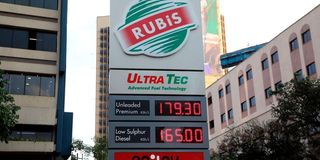East Africa’s economic recovery falters on debt, fiscal deficits

A filling station in Kenya displaying fuel prices. EA’s pace of economic recovery from the pandemic faces new threats from rising crude prices and the Russia-Ukraine war that has disrupted global supply chains .
The increasing risk of debt distress, widening fiscal and current deficits and limited economic diversification plans in the economies of East Africa, have combined to weaken prospects for growth this year.
The African Development Bank forecasts the region’s GDP at four per cent this year, before recovering to 4.7 per cent in 2023, helped by the reopening of the economies after the Covid-19 containment measures.
However, countries are yet to achieve their pre-Covid growth levels, according to the bank’s East Africa Regional Economic Outlook 2022 released last week.
According to the report, the projected strong growth is not uniform across the wider eastern African region, with top performers being Ethiopia, Kenya, Rwanda, Seychelles, Tanzania, and Uganda.
Invasion of Ukraine
The Russian invasion of Ukraine, which has increased global food and energy prices, could further slow the economic recovery, according to AfDB.
The report reviews economic performance of 13 countries (Burundi, Comoros, Djibouti, Eritrea, Ethiopia, Kenya, Rwanda, Seychelles, Somalia, South Sudan, Sudan, Tanzania, and Uganda) over the past year with short to medium-term projections.
According to the IMF review of fuel taxes remains an option for countries seeking to deal with the high fuel prices and surging inflation in the region but this will depend with the countries’ internal revenue and expenditure policies.
Harsh, unpopular prescriptions
The fund has also backed elimination of fuel subsidies, prudent management of public resources, complete reforms of inefficient and loss-making state-owned enterprises and balanced funding plan tilted towards concessional loans to help navigate the biting economic crisis. consider those taxes (fuel taxes) are things that countries can consider. Countries have the options
“The options to to consider the domestic tax systems and reform measures taking into account the specific government policies. It is a sovereign decision they can make,” said Catherine Pattillo, the fund’s Deputy Director-in-charge of African Department.
Rising crude prices
EA’s pace of economic recovery from the pandemic faces new threats from rising crude prices and the Russia-Ukraine war that has disrupted global supply chains leading to higher food and energy prices, depreciating currencies, and falling forex reserves.
Currency depreciations have resulted in higher energy and wheat prices in local currency terms compared with the price in dollars. Also, consultants at Deloitte say EA countries are going through difficult period that will see economic decline this year, driven by political instability and unreliable rainfall that has adversely impacted agricultural yields.
The economists in the report “Resilience through tough times” show that the region’s GDP has been heavily impacted by political instability in Kenya and Ethiopia, the major economic growth drivers in the region, and reduced agricultural sector growth.
EA’s inflation is forecast to increase to 8.6 per cent in 2022 from 7.7 per cent in 2021 driven by elevated global food and energy prices, amid Russia’s invasion of Ukraine.
According to the World Bank’s latest Commodity Markets Outlook report released last week the weakening of currencies of most developing economies is driving up food and fuel prices in ways that could deepen the food and energy crises.
Elevated prices of energy commodities that serve as inputs to agricultural production have been driving up food prices, with food inflation in Africa averaging between 12 and 15 per cent.
Globally, energy prices are forecast to still be 75 per cent above their average over the past five years , next year while the price of Brent crude oil is expected to average $92 a barrel in 2023 — well above the five-year average of $60 a barrel.
“The forecast of a decline in agricultural prices is subject to an array of risks,” said John Baffes, Senior Economist in the World Bank’s Prospects Group.
Globally, inflation is expected to increase to 9.2 per cent in 2022 from 5.3 percent in 2021 largely attributable to the high energy and food inflation that is a result of negative spillover stemming from the Russia-Ukraine conflict.





